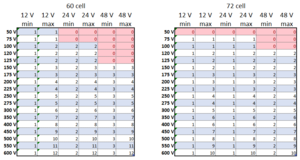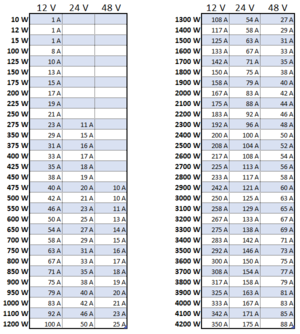Simplified MPPT charge controller sizing and selection
A MPPT charge controller is rated to operate at a particular DC system voltage, maximum current and maximum voltage. MPPT charge controllers can charge the battery bank with any series and parallel configuration of modules that doesn't exceed the maximum voltage and maximum current or drop below the required charging voltage of the energy storage system. Exceeding the voltage rating of an MPPT due to cold temperatures can damage it. Many charge controllers allow the current rating to be exceeded to a certain point without damage, just lost energy - it depends on the charge controller. There are several important calculations that must be performed to properly size an MPPT charge controller:
- Should be sized to work with a series and parallel PV source circuit configuration of the PV source that will not damage the charge controller due to high voltages resulting from low temperatures at the project location.
- Should be sized to work with a series and parallel PV source circuit configuration of that will still be able to properly charge the energy storage system under high temperatures and as PV modules age at the project location.
Assumptions:
- Minimum ambient temperature: -15°C
- Maximum ambient temperature: 50°C
- Conservative estimates for PV module voltages are used that cover nearly all 60 and 72 cell solar modules.
Contents
Step 1: Determine PV module power rating
60-cell and 72-cell modules are the most common module size used with MPPT charge controllers. They range in size from 250W - 400W+.
Step 2: Determine minimum number of PV modules
This calculation will give a minimum number of modules. The final array size should always be larger than this value, thus if the result of the calculation is a decimal, it should be rounded up. Different modules sizes and configurations can be explored to find the optimal design.
| Minimum number of PV modules | = Minimum PV source size ÷ PV module power rating (Step 1) |
|---|
Step 3: Minimum PV source power rating
This calculation will give a power rating of the PV source based upon the chosen module size and the number of modules required.
| Minimum PV source power rating | = Minimum number of PV modules (Step 2) × PV module power rating (Step 1) |
|---|
Step 4: Choose MPPT charge controller and PV source series/parallel configuration
It is necessary to test various different configurations of PV modules and charge controllers to find the best configuration. The DC system voltage, number of PV modules, input voltage of the charge controller, the number of modules in series, the number of parallel circuits, and the current rating of the charge controller can all be varied to find the best design. The number of PV modules should be higher than the minimum The final PV source and charge controller configuration must meet all of the following requirements:
- An MPPT charge controller will have a maximum input voltage rating that cannot be exceeded, even under extreme temperatures. This maximum input voltage rating limits the possible configurations of PV modules that can be used to achieve the desired minimum PV source size.The chart below gives maximum and minimum numbers of PV modules in series per PV source circuit for 60 and 72 cell modules. All of the PV source circuits must have the same number of PV modules if there is a single charge controller or else it will not function properly (the number of modules in series therefore must divide evenly into the minimum number of PV modules required). If there are multiple charge controllers, then the number of modules connected in series per PV source circuit should be the same for each one. As long as the voltage doesn't exceed the rating of the charge controller(s), more PV modules per PV source circuit is generally preferrable as it permits smaller sized wires and minimizes voltage drop.
- Can handle the total current supplied by the PV source with the desired PV module configuration. An MPPT charge controller is capable of of accepting varying voltages from the array and converting them into current at the proper charging voltage for the energy storage system. The maximum current of the PV source can be calculated by dividing the power rating of the PV source by the DC system voltage as in the chart below. Larger systems often require multiple charge controllers operating in parallel. The next largest charge controller size should be chosen unless the charge controller manufacturer permits oversizing the array. Common MPPT charge controller current ratings: 10 A, 15 A, 20 A, 25 A, 30 A, 35 A, 40 A, 45 A, 50 A, 55 A, 60 A, 65 A, 70 A, 75 A, 80 A, 85 A, 90 A, 95 A, 100 A.
- Can function at the DC system voltage. If a very high current rating is required for the charge controller, increasing the DC system voltage can yield a better system design.


Notes/references
- 60 cell Voc = 41 V
- 60 cell Vmp = 27 V
- 72 cell Voc = 50 V
- 72 cell Vmp = 34 V
TkVoC = -0.36 %/C TkPmp = -0.48 %/C